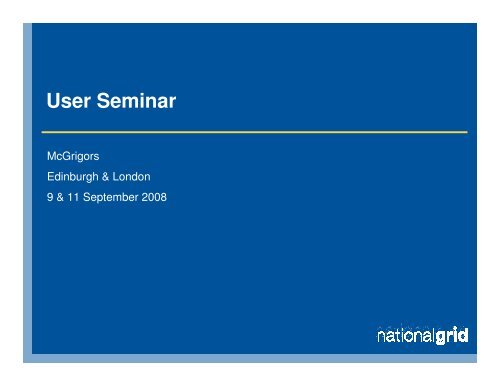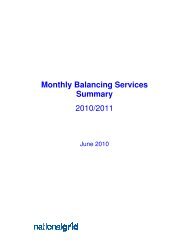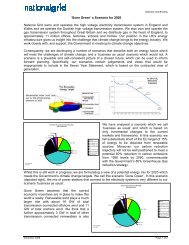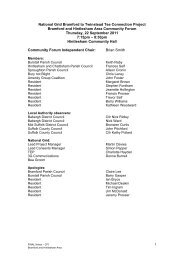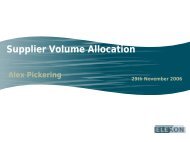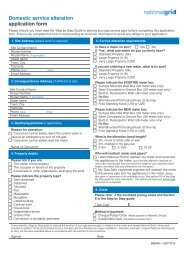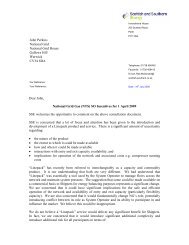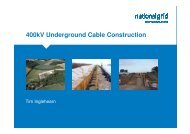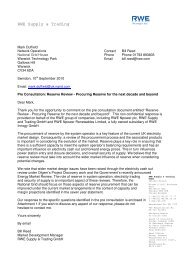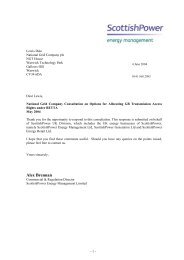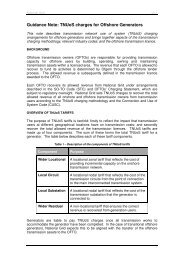GB Queue Management - National Grid
GB Queue Management - National Grid
GB Queue Management - National Grid
You also want an ePaper? Increase the reach of your titles
YUMPU automatically turns print PDFs into web optimized ePapers that Google loves.
User Seminar<br />
McGrigors<br />
Edinburgh & London<br />
9 & 11 September 2008
Introduction & Welcome<br />
Alison Kay<br />
Commercial Director, Transmission
Introductions<br />
� Alison Kay<br />
� Stuart Cook - Ofgem<br />
� Phil Collins<br />
� Chris Sambridge<br />
� Chris Newitt<br />
� Neil Carter
Overview of Day<br />
� Update on Transmission Access Review (TAR)<br />
� Discuss the Ofgem/BERR TAR Final Report<br />
� Introduce the Interim Measures<br />
� Provide update on progress with optimisation and advancement of<br />
projects<br />
• What’s driving the making of connection offers far into the future?<br />
� Provide updates on recent and ongoing developments
Transmission Access Review<br />
<strong>National</strong> <strong>Grid</strong> View<br />
Alison Kay<br />
Commercial Director, Transmission
Agenda<br />
� Introduction<br />
� Transmission Access Reform<br />
� Models<br />
� Working Group progress<br />
� Timescales
Introduction<br />
� European Union has recently agreed that by 2020 one-fifth<br />
of all Europe’s energy should come from renewable<br />
sources<br />
� In line with this, European Commission has proposed a<br />
target of 15% for UK<br />
� UK Government has stated its firm commitment to meeting<br />
its fair share of the European target<br />
� Achieving this could require renewable generators to<br />
provide between 30 and 40% of our electricity supplies<br />
� A significant proportion of our existing generation will also<br />
need to be replaced over the same period<br />
� Unprecedented challenge for electricity networks
How do we get there?<br />
Two issues to solve…<br />
1. Build more transmission<br />
capacity faster<br />
2. Allocate available<br />
transmission capacity<br />
more sensibly<br />
The proposals…<br />
1. “Strategic Investment” in<br />
transmission<br />
2a. Interim Connect & Manage<br />
2b. Transmission Access Reform
A different approach<br />
� <strong>National</strong> <strong>Grid</strong> has proposed a suite of framework changes<br />
that could be used to implement 3 access straw men<br />
� Why?<br />
� Consideration of all options more likely to result in the<br />
right answer<br />
� <strong>National</strong> <strong>Grid</strong> has organised these proposals into 3<br />
working groups which consider access (CUSC) and<br />
charging together<br />
� Why?<br />
2b. Transmission Access Reform<br />
� Concerns expressed by industry – difficult to discuss<br />
CUSC and charging issues in isolation
What’s wrong?<br />
� New generation can’t get timely access to the<br />
transmission system<br />
� <strong>GB</strong> queue stretching out beyond 2020<br />
� Closure uncertainty<br />
2b. Transmission Access Reform<br />
� May not be appropriate with increased volume of<br />
renewable generation<br />
� Characteristics of wind mean that sharing of<br />
capacity (between wind and conventional)<br />
much more important
What are the models?<br />
� Connect & manage<br />
2b. Transmission Access Reform<br />
� Firm connection date provided by SO in exchange for firm<br />
financial commitment<br />
� Operational costs caused when reinforcements cannot be<br />
completed are socialised<br />
� Evolutionary change<br />
� Flexible, cost-reflective short-term access regime<br />
� Finite, tradable long-term access rights<br />
� Capacity auctions<br />
� As evolutionary change, but long-term access rights are allocated<br />
by auction<br />
� All models get new generation connected more quickly<br />
� Different consequences for on-going regime
WG1: Short-term<br />
The Working Groups<br />
WG2: Long<br />
term<br />
WG3: Supporting<br />
changes<br />
CAP162: Entry<br />
overrun<br />
CUSC<br />
CAP161: SO release of<br />
short-term rights<br />
CAP163: Entry capacity<br />
sharing<br />
CAP165: Finite longterm<br />
entry rights<br />
CAP166: Entry<br />
capacity auctions<br />
Local only<br />
applications<br />
CAP164: Connect<br />
and manage<br />
2b. Transmission Access Reform<br />
Charging<br />
Methodology<br />
Ex post cost<br />
reflective charge<br />
Fixed price<br />
tariffs<br />
Auction resultant<br />
changes<br />
Zoning<br />
criteria<br />
Local asset<br />
charging<br />
TNUoS residual<br />
charge<br />
Other<br />
Capacity release<br />
methodology<br />
Zonal definition<br />
methodology
Progress<br />
� The good news….<br />
2b. Transmission Access Reform<br />
� Significant commitment from industry participants<br />
� High level of engagement and expertise is moving<br />
thinking forward<br />
� But….<br />
� Progressing 6 fundamental CUSC amendments and<br />
charging modifications in parallel is a huge task<br />
� More time is required to further develop and robustly<br />
assess the proposals<br />
� The working group timescales have been extended by 2<br />
months<br />
� This can be accommodated without jeopardising April<br />
2010 implementation date
Timeline<br />
2008 2009<br />
Mar Apr May Jun Jul Aug Sep Oct Nov Dec Jan Feb<br />
18 March; High-level industry seminar<br />
10 April; Workshop on draft mods<br />
25 April; Raise CUSC mods<br />
29 April<br />
Transmission Charging Methodologies Forum (TCMF)<br />
2b. Transmission Access Reform<br />
22 August; TCMF<br />
CUSC Working Groups<br />
CUSC consultation period<br />
18 Dec; CUSC panel vote<br />
Amendment reports<br />
to Ofgem<br />
Charging Working Groups<br />
Charging consultations<br />
Charging conclusions<br />
reports to Ofgem
Questions?
Optimisation<br />
Chris Sambridge<br />
Customer Services
Agenda<br />
� The Purpose<br />
� Users Aspirations<br />
� Contracted Background<br />
� The Process<br />
� Contacting Users - Timeline<br />
� Recent Example
<strong>GB</strong> <strong>Queue</strong> <strong>Management</strong><br />
� Panel Members<br />
� <strong>GB</strong>SO, 3 x TO, Ofgem<br />
� Purpose<br />
� Consider any requests to advance to an earlier<br />
connection date<br />
� Identification of any available transmission<br />
capacity<br />
� Identification of developers able to make use of<br />
available capacity<br />
� <strong>Management</strong> of the Offer process
Users Aspirations<br />
� User Quarterly Reports establish the status of each<br />
scheme in terms of;<br />
� Earliest date development could connect<br />
� Minimum MW able to connect<br />
� Phasing (if applicable) (MW and date for each phase)<br />
� Status of scheme (in planning, consented, plant<br />
purchase<br />
� All developers with a ConsAg submit directly to NGET<br />
� BELLA & “Small” parties submit via DNO<br />
� Can be amended at any time<br />
� NGET Passes to TO’s to determine availability of capacity
Users Aspirations (2)<br />
�User response to QRs<br />
� 175 Projects with ConsAgs<br />
� 40 QRs received<br />
� = ~23%<br />
N.B. Contractually NGET require a new QR each<br />
quarter
Contracted Background<br />
� NGET establish and maintain a Contracted Background-SYS data<br />
� Contracted Background used to identify spaces within localised<br />
boundaries<br />
� Construction Planning Assumptions (CPA) are updated following<br />
change in Contracted Background i.e.<br />
� New Agreements<br />
� Delays<br />
� Reductions in MW<br />
� Terminations<br />
� CPA sent to each TO<br />
� TO maintains boundary Capacity Schedules<br />
� TO reviews Capacity Schedule and Aspirational Background plus<br />
other transmission system data and conducts studies to determine<br />
capacity gaps.
<strong>GB</strong> <strong>Queue</strong> <strong>Management</strong> Panel - Process<br />
� Meeting held monthly<br />
� Gap analysis looks at connections year on year<br />
�To identify total capacity available<br />
�To identify number of Users ‘who can use it’<br />
�To identify ‘who can’ connect & when starting<br />
from 2008/09
Contacting Users - Timeline<br />
� Quarterly Report submitted by TO/Developers/Users/DNOs<br />
in accordance with contracts<br />
� <strong>GB</strong>SO / TO Monthly Meeting QR+10<br />
� Users Contacted by <strong>GB</strong>SO MM+5<br />
� User Submits Mod App & Indemnity UC+15<br />
� Clock Start D+1<br />
� Offer Submitted by TO to <strong>GB</strong>SO CS+75<br />
� Offer Submitted by <strong>GB</strong>SO to Developer/User/DNO CS+90<br />
days<br />
� Offers may go interactive
Recent Example of <strong>Queue</strong> <strong>Management</strong><br />
Full Full<br />
Pre B-D B-D dependant Post 2016
Recent Example of <strong>Queue</strong> <strong>Management</strong><br />
Akron<br />
Gordon Bush<br />
Lairg<br />
Fairburn<br />
Others<br />
Glendoe<br />
Others<br />
Others<br />
Pre B-D B-D dependant Post 2016
Recent Example of <strong>Queue</strong> <strong>Management</strong><br />
Akron<br />
Gordon Bush<br />
Lairg<br />
Fairburn<br />
Others<br />
Glendoe<br />
Others<br />
Others<br />
Pre B-D B-D dependant Post 2016
Recent Example of <strong>Queue</strong> <strong>Management</strong><br />
Glendoe<br />
Others<br />
Others<br />
Others<br />
Pre B-D B-D dependant Post 2016
Next steps<br />
Glendoe<br />
Others<br />
Others<br />
Others<br />
Pre B-D B-D dependant Post 2016
Questions?
Coffee<br />
Back at 11:05
Transmission Access Review<br />
Ofgem presentation at NGET user seminars<br />
9 September 2008 – Edinburgh<br />
11 September 2008 – London
<strong>GB</strong> transmission network will need to connect<br />
a substantial volume of new generation<br />
Existing arrangements are not fit for purpose. Significant queue of generators waiting to<br />
connect. Transmission investment lags behind generation investment<br />
• The existing <strong>GB</strong> transmission system connects c80GW of generation to meet<br />
around 60-65GW peak demand<br />
• To meet 2020 targets will require an additional 60GW+ of renewable capacity,<br />
the majority of which will be onshore and offshore wind, plus:<br />
– Thermal (fossil) backup plant given intermittency of wind;<br />
– Around 20GW of existing generation is expected to close by 2020 and<br />
distributed generation will also have an impact<br />
– There will also be new nuclear, gas and clean coal<br />
• Connections may be remote from the existing network resulting in potential<br />
planning difficulties<br />
Longer term targets create major uncertainties and challenges for Ofgem, HMG and<br />
companies . This isn’t just a renewables issue. Need for radical reform and innovation.<br />
32
The transmission access review package<br />
Planning &<br />
Incentives<br />
• TSOs to publish a major technical study by end of 2008.<br />
Brought together through ENSG<br />
• Ofgem to develop sharper incentives for TSOs, in particular,<br />
new investment incentives for TOs to take some of stranding<br />
risk (but with higher reward for timely & efficient investment)<br />
• Linked to ongoing review of SO incentives<br />
33
The transmission access review package<br />
Planning &<br />
Incentives<br />
Enduring<br />
access<br />
arrangements<br />
• TSOs to publish a major technical study by end of 2008.<br />
Brought together through ENSG<br />
• Ofgem to develop sharper incentives for TSOs, in particular,<br />
new investment incentives for TOs to take some of stranding<br />
risk (but with higher reward for timely & efficient investment)<br />
• Linked to ongoing review of SO incentives<br />
• Amendment proposals on commercial arrangements and<br />
charging methodology<br />
• Modular approach, capable of delivering a range of different<br />
regimes<br />
• Possible implementation around April 2010<br />
34
The transmission access review package<br />
Planning &<br />
Incentives<br />
Enduring<br />
access<br />
arrangements<br />
Short term<br />
measures (a<br />
form of<br />
“connect &<br />
manage”)<br />
• TSOs to publish a major technical study by end of 2008.<br />
Brought together through ENSG<br />
• Ofgem to develop sharper incentives for TSOs, in particular,<br />
new investment incentives for TOs to take some of stranding<br />
risk (but with higher reward for timely & efficient investment)<br />
• Linked to ongoing review of SO incentives<br />
• Amendment proposals on commercial arrangements and<br />
charging methodology<br />
• Modular approach, capable of delivering a range of different<br />
regimes<br />
• Possible implementation around April 2010<br />
• Improving management of existing “queue” of generators<br />
• Measures to release and utilise the full capacity of the system<br />
• Scope to connect more generation through limited<br />
derogations from security standards? Criteria include:<br />
Benefits > Costs.<br />
35
Derogation from <strong>GB</strong>SQSS – requests from licensees<br />
• Transmission licensees are obliged to comply with <strong>GB</strong>SQSS, unless the<br />
Authority directs otherwise<br />
• Where a licensee assesses that it is not in a position to comply, or<br />
compliance may result in an inefficient outcome either in short or longer<br />
term, it may submit a request to Ofgem for a derogation<br />
• Requests from licensees for derogation should include:<br />
– a clear description of the non-compliance and requested duration of derogation<br />
– a comprehensive, and where possible, quantitative assessment of the impacts of<br />
the non-compliance. For example for the interim measures for transmission<br />
access, this should include impacts on:<br />
• difference in generation profile<br />
• carbon emission<br />
• volume and costs of transmission constraints<br />
• other parties, such as operational restrictions on other generators<br />
• health and safety<br />
– proposal for restoring compliance (if appropriate)<br />
– a description of the reasonable alternative actions that have been considered<br />
36
Derogation from <strong>GB</strong>SQSS – evaluation by Ofgem<br />
• Each derogation request is assessed by Ofgem individually on its merits<br />
• In its assessment, Ofgem, having regard to its principal objective and its<br />
general duties, including our duties in respect of sustainable development,<br />
will consider the impact on:<br />
– Consumers: eg costs and/or security of their electricity supply<br />
– Competition: eg concerns about market power<br />
– Sustainable development: eg carbon emissions reduction through earlier<br />
connection of renewable generation<br />
– Health & safety: eg as advised by relevant government bodies<br />
– Other parties affected: eg the ability of the <strong>GB</strong>SO or DNOs to operate their<br />
systems<br />
• Ofgem’s assessment will also take into account:<br />
– Relevant precedent derogations already granted by Ofgem<br />
– The likelihood of similar derogation requests in the future<br />
– Allowances that have been made in current and previous price controls<br />
37
Derogation from <strong>GB</strong>SQSS – criteria and decision<br />
• Criteria for justifying a derogation are set out in the “Guidance on licence<br />
derogation requests” and include:<br />
– No significant risks or avoidable adverse impacts to the licensee, other licensees<br />
or connected customers<br />
– Robust, economic case from the applicant that supports the proposed action<br />
• The guidance note is being updated – Ofgem to consult on it shortly<br />
• A derogation may be granted with time limits or conditions in respect of<br />
the wider system<br />
• In the context of transmission access reform, the TSOs are expected to<br />
work with the users to identify opportunities to use derogation to achieve<br />
earlier connection of generation projects ahead of the introduction of<br />
reformed enduring access arrangements<br />
38
Implementing TAR – Interim Measures<br />
Phil Collins and Chris Newitt
Agenda<br />
� Current <strong>GB</strong> <strong>Queue</strong><br />
� Communication of Project Status<br />
� Release of capacity<br />
� Interim measures<br />
� Improved <strong>GB</strong> <strong>Queue</strong> <strong>Management</strong><br />
� Early implementation of<br />
� Access Sharing (CAP163)<br />
� SO Release of short term access (CAP161)<br />
� Interim Connect & Manage
MW<br />
<strong>GB</strong> <strong>Queue</strong> - Consents Status<br />
60000<br />
50000<br />
40000<br />
30000<br />
20000<br />
10000<br />
0<br />
2008 2009 2010 2011 2012 2013 2014 2015 2016 2017 2019 2021 2022<br />
Year<br />
Constructed Under Construction Application Approved Under Consideration Scoping
Scotland Consents Status<br />
MW<br />
12000<br />
10000<br />
8000<br />
6000<br />
4000<br />
2000<br />
0<br />
2008 2009 2010 2011 2012 2013 2014 2015 2016 2017 2019<br />
Year<br />
Constructed Under Construction Application Approved Under Consideration Scoping
<strong>GB</strong> Renewables - Consents Status<br />
MW<br />
18000<br />
16000<br />
14000<br />
12000<br />
10000<br />
8000<br />
6000<br />
4000<br />
2000<br />
0<br />
2008 2009 2010 2011 2012 2013 2014 2015 2016 2017 2019<br />
Year<br />
Renewable - Constructed Renewable - Under Construction Renewable - Application Approved<br />
Renewable - Under Consideration Renewable - Scoping
Scotland Renewable - Consents Status<br />
MW<br />
12000<br />
10000<br />
8000<br />
6000<br />
4000<br />
2000<br />
0<br />
2008 2009 2010 2011 2012 2013 2014 2015 2016 2017 2019<br />
Year<br />
Constructed Under Construction Application Approved Under Consideration Scoping
Communication of Project Status<br />
� Achieved via Quarterly Reports<br />
� Submission rate currently ~23%<br />
� Considering making submission mandatory<br />
� Other incentives<br />
� Name & Shame/Fame<br />
� Contacting of senior management<br />
� Delaying opportunity to be advanced<br />
� Recognise need to improve TO Reports
Release of Capacity<br />
� Capacity released following change in Contracted<br />
Background i.e.<br />
� Delays<br />
� Reductions in MW<br />
� Terminations<br />
� CPA sent to each TO<br />
� TO maintains boundary Capacity Schedules<br />
� TO reviews Contracted and Aspirational Background<br />
plus other transmission system data to determine who<br />
can use the capacity the earliest.
Release of Capacity<br />
� CAP150 – Capacity Reduction Clause<br />
� CUSC Amendment submitted to allow timely<br />
release of capacity<br />
� Modification was approved earlier this year<br />
� ConsAgs currently being amended<br />
� Certain developers appear not to be progressing<br />
projects<br />
� Users will be contacted prior to receiving amended<br />
agreement
Capacity Recently Released<br />
� Fairwind Statkraft Orkney – 126MW<br />
� Perth (Dunan) – 38MW<br />
� Pairc – 156MW<br />
� Glendoe (advancing) 51.5MW<br />
� Projects to be identified at next optimisation<br />
meeting
Better <strong>GB</strong> <strong>Queue</strong> <strong>Management</strong><br />
� Submission of project status<br />
� Use of CAP150 rights<br />
� Identification of capacity<br />
� Utilisation of other contractual rights<br />
� Ofgem invited to <strong>GB</strong> <strong>Queue</strong> <strong>Management</strong><br />
meetings<br />
� Improved communication back to developers on<br />
request to advance<br />
� Reporting of progress to industry and Ofgem
Interim measures<br />
� The enduring access working groups will consider<br />
whether the following can be implemented by April<br />
2009:<br />
� SO release of short-term access rights<br />
(CAP161)<br />
� Entry capacity sharing (CAP163)<br />
2a. Interim connect & manage<br />
� <strong>National</strong> <strong>Grid</strong> has been working with Ofgem to<br />
define a process in which derogations from<br />
<strong>GB</strong>SQSS can be used to provide access ahead of<br />
the completion of certain reinforcements
Interim Connect & Manage<br />
� TAR Final Report identified scope to connect more<br />
generation through derogations from <strong>GB</strong>SQSS<br />
� Open letter released 8 September 2008<br />
� Short term measure only<br />
� Different to the Connect and Manage CUSC<br />
Amendment<br />
� Not limited to BCAs & BEGAs<br />
� Ofgem to develop guidance on requesting<br />
derogations<br />
� How much can this initiative deliver?
Interim Connect and Manage - How<br />
� Authority to consider requests on assessment of<br />
costs and benefits<br />
� Appropriate Cost Benefit Analysis<br />
(Costs
Interim Connect and Manage<br />
� Extension of current methodology<br />
� Allows projects to be considered where no or limited<br />
capacity is available<br />
� Projects need to have consents to be considered<br />
� Projects need to be able to demonstrate ability to advance<br />
� Developers need to work with <strong>GB</strong>SO/TOs<br />
� Identify project lead times<br />
� Minimise constraint costs<br />
� Identify possible connection options<br />
� Develop appropriate cost benefit
Interim Connect and Manage<br />
� <strong>GB</strong> <strong>Queue</strong> <strong>Management</strong> Methodology to be<br />
revised<br />
� Comments sought on clarity<br />
� Need to show progress as an industry<br />
� Methodology/guidance between TOs published<br />
� Approach developers who can build the soonest<br />
� Preferably within TAR implementation<br />
timescales<br />
� Progress reported to industry
Connection Only<br />
� Request for local works to be complete<br />
� Allows use of short term access products when<br />
connected<br />
� Need to have a BCA or a BEGA to be able to use<br />
short term products<br />
� May achieve the same as Interim Connect &<br />
Manage for some projects<br />
� Speak to Agreement Manager<br />
� Apply via a Modification Application
Lunch<br />
Back at 13:15
Industry Presentation<br />
Neil Carter<br />
System Development – South West Team<br />
<strong>National</strong> <strong>Grid</strong>
Capacity (GW)<br />
Existing and Planned Contracted Generation<br />
130<br />
120<br />
110<br />
100<br />
90<br />
80<br />
70<br />
60<br />
50<br />
40<br />
30<br />
20<br />
10<br />
0<br />
Demand (GW)<br />
08/09 09/10 10/11 11/12 12/13 13/14 14/15 15/16 16/17 17/18 18/19 19/20 20/21 21/22<br />
Year<br />
Biomass<br />
Offshore Wind<br />
Wind<br />
Hydro<br />
Pumped Storage<br />
Oil + AGT<br />
OCGT<br />
Coal + AGT<br />
CHP<br />
CCGT<br />
Interconnector<br />
Nuclear<br />
Demand
Potential Future Developments<br />
England and Wales<br />
1 – 4 GW<br />
0.5 – 2 GW<br />
0.5 – 2 GW<br />
TAN8<br />
R3 Offshore Wind<br />
Nuclear<br />
Interconnectors<br />
0.5 – 1 GW 0.5 – 1 GW<br />
5 – 15 GW<br />
� Further offshore wind<br />
leasing targeted to deliver<br />
25GW by 2020<br />
� Political will for nuclear<br />
replanting<br />
� EU directive for greater<br />
interconnection<br />
� Target of 30 – 40%<br />
generation from renewable<br />
(i.e. wind) sources could<br />
require a plant margin of 40<br />
– 60%*<br />
* Dependent on assumed contribution of wind to demand security at peak
Opportunities
Connection Restrictions<br />
� System Capacity – Issue as a result of project<br />
� Reinforcements and complexity<br />
� System access requirements<br />
� Consents – Outside NG control<br />
� Resources – Mainly within NG control
Reinforcement and Complexity<br />
� Designing an efficient and economic Transmission System<br />
is a complex task. Need to consider:<br />
� System resilience<br />
� Planned and unplanned outages<br />
� Lack of clarity regarding closures leading to potential<br />
over-investment (6 month notification)<br />
� Historic boundary capability margins have been squeezed<br />
and continue to be reduced<br />
� Combination of increasingly complex designs, tight<br />
construction programmes and new technology increases<br />
risk to security of supply
Thames Estuary:- existing network<br />
West Ham<br />
Hurst<br />
Rowdown<br />
Barking<br />
Littlebrook<br />
Bramford/<br />
Braintree<br />
Tilbury<br />
West Thurrock<br />
Northfleet East<br />
Singlewell<br />
Rayleigh Main<br />
Kingsnorth<br />
Coryton<br />
Kemsley<br />
Canterbury<br />
North<br />
Grain
Example Complex Thames Estuary works<br />
West Ham<br />
Hurst<br />
Rowdown<br />
Barking<br />
Littlebrook<br />
West Thurrock<br />
Bramford/<br />
Braintree<br />
Tilbury<br />
Northfleet East<br />
Singlewell<br />
Kingsnorth<br />
Rayleigh Main<br />
Coryton<br />
Kemsley<br />
Grain
System Access<br />
� ‘Outages’ are necessary to work on existing assets and to<br />
connect new assets<br />
� Outage planning and consenting timescales are used to<br />
determine connection date – now more likely to be outage<br />
system access.<br />
� Planning outages is a complex task: -<br />
� Planned outages can only be taken from March –<br />
October in any given year<br />
� Only limited outages can be taken at one time to<br />
ensure security of supply<br />
� Outage programme must account for maintenance and<br />
asset replacement activity (try to nest where possible)<br />
� For the worst case conductor systems, re-conductoring<br />
of existing circuits can be completed at a maximum<br />
rate of 3km per ‘line gang’/week.
Time scales for presently signed Generation and<br />
Demand Connections in South Wales<br />
2008 2009 2010 2011 2012 2013 2014 2015 2016<br />
RWE<br />
Npower<br />
Pembroke<br />
Stage 1<br />
1200MW<br />
April<br />
2010<br />
RWE<br />
Npower<br />
Pembroke<br />
Stage 2<br />
800MW<br />
October<br />
2010<br />
Severn<br />
Power<br />
Uskmouth<br />
850MW<br />
August<br />
2010<br />
Prenergy<br />
Power<br />
Margam<br />
350MW<br />
August<br />
2011<br />
WPD<br />
Swansea<br />
Demand<br />
630MW<br />
October<br />
2011<br />
Nuon UK<br />
Projects<br />
Rhigos<br />
299MW<br />
October<br />
2011<br />
PB Alt En<br />
Ltd<br />
Baglan-B<br />
Stage 1<br />
435MW<br />
October<br />
2014<br />
PB Alt En<br />
Ltd<br />
Baglan-B<br />
Stage 2<br />
435MW<br />
October<br />
2016
South Wales Outages Required to Deliver Contracted Position<br />
by 2016<br />
G<br />
RWE<br />
PEMB<br />
2GW<br />
PEMB<br />
400kV<br />
BPAE<br />
Phase 2<br />
425MW<br />
KEY<br />
G<br />
PREN<br />
350MW<br />
Outages 2008-10<br />
Outages 2010-12<br />
Outages 2012-14<br />
Outages 2014-16<br />
G<br />
G<br />
BA<strong>GB</strong><br />
275kV<br />
BA<strong>GB</strong><br />
520MW<br />
Dashed represents line<br />
outages associated with turn-in<br />
to new substation assets<br />
BPAE<br />
Phase 1<br />
425MW<br />
G<br />
MAGA<br />
275kV<br />
PYLE<br />
275kV<br />
SWAN<br />
400kV<br />
SWAN<br />
275kV<br />
RHIG<br />
299MW<br />
ABTH<br />
275kV<br />
G<br />
G<br />
G<br />
ABTH<br />
1455MW<br />
RHIG<br />
400kV<br />
CARE<br />
275kV<br />
AES BARRY<br />
(EMBEDED) 230MW<br />
UPPB<br />
275kV<br />
SEVERN<br />
POWER USKM<br />
850MW 363MW<br />
TREM<br />
275kV<br />
G G<br />
USKM<br />
275kV<br />
CILF<br />
400kV<br />
WHSO<br />
275kV<br />
RASS<br />
400kV<br />
IMPP<br />
400kV<br />
IROA<br />
275kV<br />
WALH<br />
400kV<br />
SOUTH<br />
WALES<br />
SYSTEM<br />
BOUNDARY<br />
Wye Valley<br />
and River<br />
Crossing<br />
River<br />
Severn<br />
Crossings<br />
SEAB<br />
400kV<br />
G<br />
MELK<br />
400kV<br />
SEAB<br />
1200MW
Consents, Wayleaves and Land Acquisition<br />
� Consents are necessary to construct new assets where<br />
existing permission does not exist<br />
� Before a planning application can be submitted, need EIA,<br />
FRA, contamination report, noise surveys, ecological etc.<br />
� Wayleaves need to be negotiated for OHL/Cables<br />
� Land must be obtained for substation compound<br />
extensions/Newbuild.<br />
� Uncertainty over timescales for existing process<br />
� Public enquiry<br />
� Appeals<br />
� CPO<br />
� Planning reform bill provides opportunity to improve<br />
transparency and targeted development
Resources<br />
� Global demand for resources increases difficultly in<br />
procurement of assets in a timely manner<br />
� Competing with development in the Middle East and Asia<br />
for plant and people<br />
� 3 year lead time for new SGT for example<br />
� 18 month lead time from firm commitment to delivery on<br />
site of GIS equipment<br />
� However, NG does not make firm commitment until<br />
consents are obtained.<br />
� This is to prevent assets being stranded should Planning<br />
not receive approval.
CAP167<br />
Definition of a threshold(s) associated a<br />
request for a Statement of Works
CAP167<br />
Defect<br />
� CUSC 6.5 requires compulsory request for Statement of<br />
Works in respect of proposed medium sized embedded<br />
generators<br />
� For proposed small generators (
CAP167<br />
Amendment proposal<br />
� Amend the CUSC to provide definitive clarification in the<br />
assessment of whether a small embedded project (or the<br />
aggregate effect of multiple projects) has a significant<br />
impact on the <strong>GB</strong> transmission system<br />
� Provide transparent criteria of whether a DNO is required<br />
to request a Statement of Works<br />
� Recommends that a CUSC Working Group is established<br />
to determine appropriate thresholds(s)
CAP167<br />
Current thoughts of the Working Group<br />
� Do not believe WG is positioned to determine accurate thresholds –<br />
<strong>GB</strong>SO is<br />
� Do not believe that MW thresholds should be hard-coded into the<br />
CUSC as this is inflexible<br />
� Recommend that an appropriate methodology and process is<br />
developed to determine MW thresholds which can be updated<br />
relatively simply<br />
� Currently considering two different sets of criteria upon which<br />
thresholds are based:<br />
� Original – Balancing Services cost and all works on transmission<br />
system<br />
� Alternative – does not take into account Balancing Services cost<br />
and only works on transmission system triggered by Small<br />
Embedded generators
CAP151-Transmission Works Register<br />
Chris Newitt
Background<br />
� CAP151 aimed to provide clearer information on<br />
dependencies between Generators and<br />
Transmission Reinforcements<br />
� Amendment approved March 2008<br />
� System went live 1 April 2008
The System<br />
� Access 2003 database<br />
� Available on request (e-mail circulation)<br />
� not everyone can use the Access 2003 file<br />
� Excel reports<br />
� Provided on the <strong>National</strong> <strong>Grid</strong> website<br />
� Excel reports truncate the information in cells<br />
� Word reports<br />
� Provided on the <strong>National</strong> <strong>Grid</strong> website<br />
� Word reports are not easily filtered
Future Developments<br />
� Develop CAP151 further<br />
� Deliver relevant information to users<br />
� What do you want to know?<br />
� Develop links with industry data sources to provide<br />
consistent information
Views Sought<br />
� Views welcomed on current solution and future<br />
developments<br />
� Send comments to:<br />
Sarah Bradford<br />
Customer Services, B3<br />
<strong>National</strong> <strong>Grid</strong> House<br />
Warwick<br />
CV34 6DA<br />
Sarah.bradford@uk.ngrid.com
Connecting for the Future<br />
Chris Newitt
Overview<br />
� <strong>National</strong> <strong>Grid</strong> are developing a report that will be<br />
published to the industry on a quarterly basis<br />
� Outline the current queue position and the make<br />
up of the queue i.e. consents status/plant type<br />
� It is designed to reduce the amount of ad-hoc data<br />
requests
What’s in it?<br />
� Information regarding the current contracted position<br />
illustrated by graphs and tables of figures<br />
� Supporting commentary explaining what the figures show<br />
� Maps illustrating the location, size and consents status of<br />
projects currently in the queue<br />
� Code and industry changes<br />
� Updates on progress made through Optimisation
When is it available?<br />
� First edition will be available during the first week<br />
of October<br />
� Published on the <strong>National</strong> <strong>Grid</strong> website every<br />
calendar quarter
That’s all folks!


